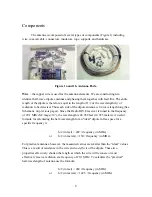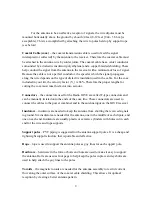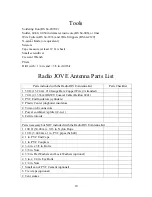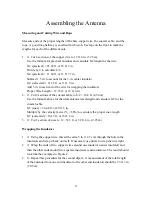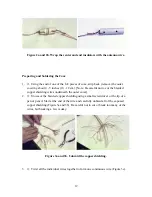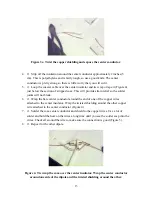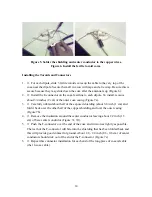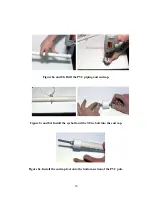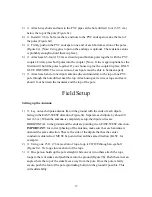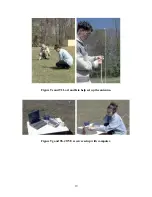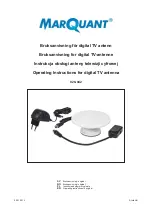
17
3)
o
Attach 4 eyebolts and nuts to the PVC pipes at the hole drilled 1 foot (30.5 cm )
below the top of the pole (Figure 8c).
4)
o
Install 4 3/8 in. bolts, washers, and nuts to the PVC endcaps to make the feet of
the poles (Figure 8d).
5)
o
Firmly push on the PVC endcaps to one end of each bottom section of the poles
(Figure 8e). [Note: Using glue to put on the endcaps is optional. The resistance alone
is probably enough to hold them in place].
6)
o
Attach each 5-foot (1.52 m) section (top and bottom pole) together with the PVC
coupler. Firmly press both poles into the coupler. [Note: Glue is again optional as the
friction will hold the poles together. If you choose to glue the coupler in place ONLY
GLUE ONE SIDE. The two sections of each pole must be able to be taken apart].
7)
o
Attach each end of one dipole antenna (the end insulator) to the top of one PVC
pole through the hole drilled near the top. Attach using extra wire or rope and leave
about 1 foot between the insulator and the top of the pole.
Field Setup
Setting up the Antenna
1)
o
Lay out each dipole antenna flat on the ground with the ends of each dipole
facing in the EAST-WEST direction (Figure 9a). Separate each dipole by about 20
feet (6.3 m). When the antenna is completely setup, the dipole wires are
HORIZONTAL to the ground and the ends are pointing in an EAST-WEST direction.
IMPORTANT: for correct phasing of the antenna, make sure that each antenna is
oriented the same direction. That is, the side of the dipole that has the center
conductor soldered to it MUST be pointed toward the same direction (EAST, for
example).
2)
o
Using one 25 ft. (7.6 m) section of rope, loop it TWICE through an eyebolt
(Figure 8c). Tie loops into each end of the rope.
3)
o
One person holds up the pole straight while one or two others attach the rope
loops to the tent stakes and push them into the ground (Figure 9b). Push them in at an
angle where the top of the stake faces away from the pole. Once the pole is fairly
secure, push the foot of the pole (protruding bolt) into the ground if possible. This
will add stability.
Summary of Contents for RJ1.1
Page 1: ...JOVE RJ1 1 Antenna Kit Assembly Manual...
Page 3: ...2...
Page 5: ...4...
Page 7: ...6...
Page 8: ...7...






